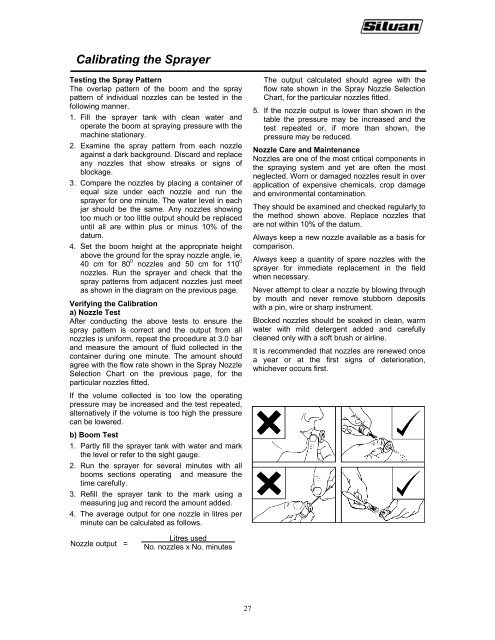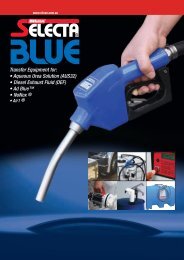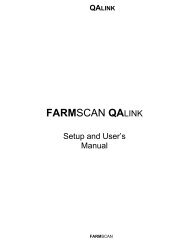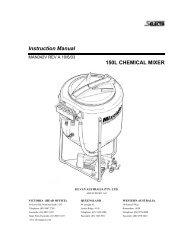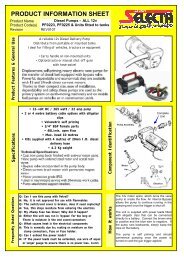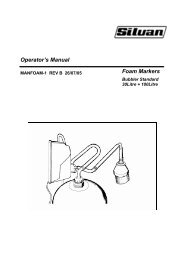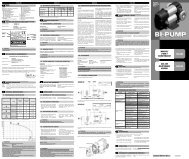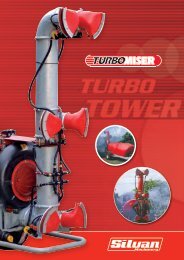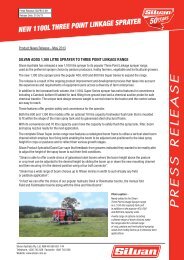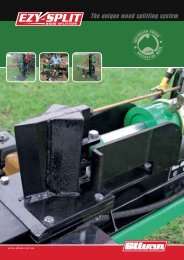Download Manual - Silvan Australia
Download Manual - Silvan Australia
Download Manual - Silvan Australia
You also want an ePaper? Increase the reach of your titles
YUMPU automatically turns print PDFs into web optimized ePapers that Google loves.
Calibrating the Sprayer<br />
Testing the Spray Pattern<br />
The overlap pattern of the boom and the spray<br />
pattern of individual nozzles can be tested in the<br />
following manner.<br />
1. Fill the sprayer tank with clean water and<br />
operate the boom at spraying pressure with the<br />
machine stationary.<br />
2. Examine the spray pattern from each nozzle<br />
against a dark background. Discard and replace<br />
any nozzles that show streaks or signs of<br />
blockage.<br />
3. Compare the nozzles by placing a container of<br />
equal size under each nozzle and run the<br />
sprayer for one minute. The water level in each<br />
jar should be the same. Any nozzles showing<br />
too much or too little output should be replaced<br />
until all are within plus or minus 10% of the<br />
datum.<br />
4. Set the boom height at the appropriate height<br />
above the ground for the spray nozzle angle, ie.<br />
40 cm for 80 0 nozzles and 50 cm for 110 0<br />
nozzles. Run the sprayer and check that the<br />
spray patterns from adjacent nozzles just meet<br />
as shown in the diagram on the previous page.<br />
Verifying the Calibration<br />
a) Nozzle Test<br />
After conducting the above tests to ensure the<br />
spray pattern is correct and the output from all<br />
nozzles is uniform, repeat the procedure at 3.0 bar<br />
and measure the amount of fluid collected in the<br />
container during one minute. The amount should<br />
agree with the flow rate shown in the Spray Nozzle<br />
Selection Chart on the previous page, for the<br />
particular nozzles fitted.<br />
If the volume collected is too low the operating<br />
pressure may be increased and the test repeated,<br />
alternatively if the volume is too high the pressure<br />
can be lowered.<br />
b) Boom Test<br />
1. Partly fill the sprayer tank with water and mark<br />
the level or refer to the sight gauge.<br />
2. Run the sprayer for several minutes with all<br />
booms sections operating and measure the<br />
time carefully.<br />
3. Refill the sprayer tank to the mark using a<br />
measuring jug and record the amount added.<br />
4. The average output for one nozzle in litres per<br />
minute can be calculated as follows.<br />
The output calculated should agree with the<br />
flow rate shown in the Spray Nozzle Selection<br />
Chart, for the particular nozzles fitted.<br />
5. If the nozzle output is lower than shown in the<br />
table the pressure may be increased and the<br />
test repeated or, if more than shown, the<br />
pressure may be reduced.<br />
Nozzle Care and Maintenance<br />
Nozzles are one of the most critical components in<br />
the spraying system and yet are often the most<br />
neglected. Worn or damaged nozzles result in over<br />
application of expensive chemicals, crop damage<br />
and environmental contamination.<br />
They should be examined and checked regularly to<br />
the method shown above. Replace nozzles that<br />
are not within 10% of the datum.<br />
Always keep a new nozzle available as a basis for<br />
comparison.<br />
Always keep a quantity of spare nozzles with the<br />
sprayer for immediate replacement in the field<br />
when necessary.<br />
Never attempt to clear a nozzle by blowing through<br />
by mouth and never remove stubborn deposits<br />
with a pin, wire or sharp instrument.<br />
Blocked nozzles should be soaked in clean, warm<br />
water with mild detergent added and carefully<br />
cleaned only with a soft brush or airline.<br />
It is recommended that nozzles are renewed once<br />
a year or at the first signs of deterioration,<br />
whichever occurs first.<br />
Nozzle output =<br />
Litres used<br />
No. nozzles x No. minutes<br />
27


